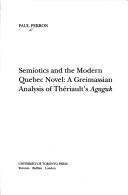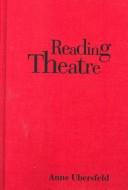| Listing 1 - 5 of 5 |
Sort by
|

ISBN: 1442683880 9781442683884 0802009263 9780802009265 Year: 1996 Publisher: Toronto
Abstract | Keywords | Export | Availability | Bookmark
 Loading...
Loading...Choose an application
- Reference Manager
- EndNote
- RefWorks (Direct export to RefWorks)
Perron distinguishes the operation of multiple signs in Agaguk and establishes a narrative grammar, based on an actional and cognitive semiotic theory, that can be applied to a text as complex as a novel. For this purpose he redefines the concept of the sign and introduces a semiotics of passions that conditions the characters' actions. All of this takes place within the context of a semiotics of the subject, where the value systems that motivate the collective must be overcome, negated, and even eradicated by the individual subject before a new moral and sexual identity can come into being, independent of the traditional body politic. Perron's Greimassian analysis of Agaguk functions as both a demonstration of the workings of that text and an example of socio-semiotic analysis, while situating literary semiotics within the larger framework of linguistic theory and literary studies. The most popular novel in Quebec since the Second World War, Yves Theriault's Agaguk was published just before the Quiet Revolution, a period of major political and cultural transformation that radically altered Quebec society at the beginning of the 1960s. In this original socio-semiotic reading of the novel in translation, inspired by A.J. Greimas and the Paris School of Semiotics, Paul Perron examines the Inuit setting and characters of Agaguk as metaphors for Quebec society. Semiotics and the Modern Quebec Novel is one of the few semiotic analyses to deal with an entire novel, and illustrates the heuristic value of this complex methodology with respect to long prose texts in English.
Semiotics and literature --- Literature and semiotics --- Literature --- Thériault, Yves. --- Québec (Province) --- Intellectual life
Book
ISBN: 1894508076 Year: 2000 Publisher: New York (N.Y.) : Legas,
Abstract | Keywords | Export | Availability | Bookmark
 Loading...
Loading...Choose an application
- Reference Manager
- EndNote
- RefWorks (Direct export to RefWorks)

ISBN: 1282037145 9786612037146 1442679026 9781442679023 0802044557 0802082408 9780802044556 9780802082404 Year: 1999 Publisher: Toronto
Abstract | Keywords | Export | Availability | Bookmark
 Loading...
Loading...Choose an application
- Reference Manager
- EndNote
- RefWorks (Direct export to RefWorks)
First published in France in 1976, Anne Ubersfeld's three-volume work, Lire le theatre, has made a resounding impact on the semiological study of drama. Reading Theatre is a long-awaited translation of the first volume.Clear and systematic in its approach, the book covers all the basic elements of theatrical text and performance. Ubersfeld begins by refuting the view of performance as the simple 'translation' of a dramatic text, and outlines a much more complex dynamic. In subsequent chapters she similarly begins with a brief critique of simplistic models and then teases out the complexities of action, character, space, time, and dialogue. A range of specific examples brings substance and clarity to her points.Ubersfeld shows how such formal analysis can enrich the work of theatre practitioners, offering a fruitful reading of the symbolic structures of stage space and time, and opening up multiple possibilities for interpreting a play's lines of action. Though firmly grounded in formalist and semiotic studies, the book exhibits a refreshing scepticism about scientific positivism, stressing the fundamental ambiguity of any dramatic text as well as the sociohistorical grounding of particular text and performance styles.A pioneering work, this contemporary classic continues to inform debates in theatre semiotics. Addressed as much to actors and directors as to students and scholars, it will be read widely in theatre circles throughout the English-speaking world.
Theater --- Semiotics --- Philosophy. --- Semiotics.
Book
ISBN: 1442697202 1442697814 9781442697201 9781442697812 9780802099266 0802099262 Year: 2009 Publisher: Toronto
Abstract | Keywords | Export | Availability | Bookmark
 Loading...
Loading...Choose an application
- Reference Manager
- EndNote
- RefWorks (Direct export to RefWorks)
The author of the widely acclaimed Morphology of the Folktale has written an original, comprehensive, and exciting study on how humour works, and on everything you wanted to know about the genre, in a clear, approachable, and insightful manner.
Comic, The, in literature. --- Laughter in literature. --- Humor in literature.
Book
ISBN: 0861879201 Year: 1987 Publisher: London : Pinter,
Abstract | Keywords | Export | Availability | Bookmark
 Loading...
Loading...Choose an application
- Reference Manager
- EndNote
- RefWorks (Direct export to RefWorks)
| Listing 1 - 5 of 5 |
Sort by
|

 Search
Search Feedback
Feedback About UniCat
About UniCat  Help
Help News
News